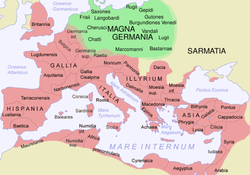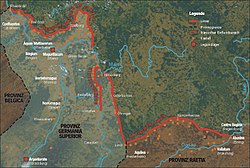Agri Decumates



Agri Decumates was a region of the Roman Empire, covering the Black Forest area between the Main river and the sources of Danube and Rhine rivers, presently in southwestern Germany. It was part of both the province of Raetia and the province of Germania Superior.
The only ancient reference to the name comes from Roman historian Tacitus. In his book Germania, Tacitus used the term Agri Decumates or decumates agri (Latin for Tenth Land) to denote the area beyond (that is, either to the east or to the north) of the rivers Rhine and Danube. The origin and meaning of the name is disputed. It may either refer to an unknown place-name Decuma or Decumum or to the fact that the region was obliged to pay tribute to the emperor by handing over a tenth of its produce. Another possibility is that, prior to Roman occupation, the area was inhabited by a tribe which divided the area into 10 cantons.[1] According to Michael Grant, the name refers to an ancient Celtic term, the precise meaning of which has been lost.[2]
According to Tacitus, the region had originally been populated by the Celtic tribe of the Helvetii but soon Germanic Suebi settled there before migrating, around 9 BCE, to Boiohaemum (modern day Bohemia). After the Suebi left, the area was again inhabited by Gauls. Later on, the region was to become part of the Roman Empire.
- Non numeraverim inter Germaniae populos, quamquam trans Rhenum Danuviumque consederint, eos qui decumates agros exercent: levissimus quisque Gallorum et inopia audax dubiae possessionis solum occupavere; mox limite acto promotisque praesidiis sinus imperii et pars provinciae habentur.[3]
- "Even though they live beyond the river Rhine and the river Danube, I would not count the inhabitants of the Tenth Land among the peoples of Germania. Careless Gauls, having become brave due to necessity, occupied the land without having any legitimate claim. Since soon afterwards a border-wall was built and fortresses were erected, it is considered to be a bulge of the Empire and part of the province."
The military occupation during the reign of Emperor Vespasian (69-79 CE) laid the foundations for Roman settlement and colonization in the region. Under Emperor Domitian, a network of roads was built covering the whole of the territory. The system of roads enabled the autorities to control and safeguard the area, easing communications between the legions stationed on the river Danube and the Rhine by shortening the Roman defenses in the area. Frontier fortifications were constructed between modern Reinbohl and Pförring.
The major places of Roman settlement were Sumolecenna, Civitas Aurelia Aquensis, Lopodunum and Arae Flaviae, modern day Rottenburg am Neckar, Baden-Baden, Ladenburg and Rottweil respectively.
The region flourished during the next two centuries in spite of periods of unrest: around 185/186, a revolt against Roman authority took place, mainly directed against the presence of the Roman military in Argentorate.
The first devastating incursion of the Germanic Alamanni tribe occurred in 233. After 259, they began to occupy the region.
The Romans controlled the province until the latter half of the 3rd century, when it was evacuated by the emperor Gallienus (259-260) in the face of invading Alamanni and the secession of much of the Western Roman Empire under the regional emperor Postumus.
The area may have been briefly reoccupied under Emperor Aurelian (270-275), during the Roman military resurgence of the late 3rd century CE. Even if this did occur, the re-establishment of Roman rule was brief. After the death of Emperor Probus (282), the area was finally given up and left to the Alamanni. The territory has since remained inhabited by people of Germanic descent continuously to this day. However, Roman settlements were not immediately abandoned. There is evidence of continuity of Roman life well into the 5th century.
Notes
References
- Bingemer, Heinrich, Das nördliche Dekumatenland vor, während und nach der Römerherrschaft, diss., Frankfurt, 1924
- Castritius, Helmut, "Das Ende der Antike in den Grenzgebieten am Oberrhein und an der oberen Donau", Archiv für hessische Geschichte und Altertumskunde NF 37, 1979, pp. 9-32
- "Agri Decumates." Encyclopædia Britannica. 2006. Encyclopædia Britannica Online. 22 Oct. 2006 http://www.britannica.com/eb/article-9004069
- Grant, Michael, A Guide to the Ancient World, A Dictionary of Classical Place Names, Barnes & Noble, 1997, ISBN 0-8242-0742-4
- Konrat Ziegler, Walther Sontheimer, August Pauly (eds.), Der kleine Pauly, München, 1979, ISBN 3-423-05963-X
- Strayer, Joseph R. (ed.), Dictionary of the Middle Ages, vol. 1, New York, 1982, ISBN 0-684-18276-9
- Geuenich, Dieter, Geschichte der Alemannen, Stuttgart, 1997, ISBN 3-17-012095-6
- Lexikon des Mittelalters, München, 1980ff., ISBN 3-423-59057-2
- Much, Rudolf, Die Germania des Tacitus, 3rd ed., Heidelberg, 1967
- Reallexikon der germanischen Altertumskunde, vol. 5, Berlin, 1984, ISBN 3-11-009635-8
- Syme, Ronald, Tacitus, vol. 1, Oxford, 1958, repr. 1985, ISBN 0-19-814327-3
